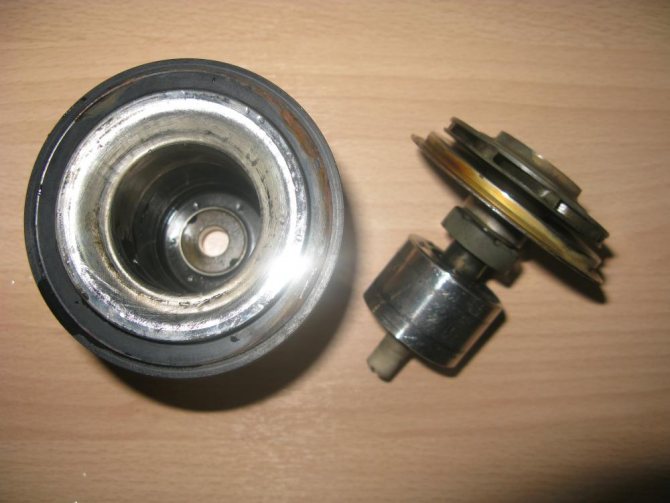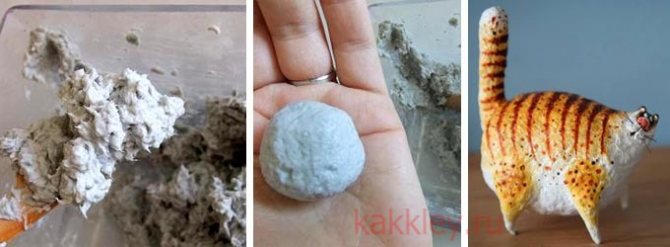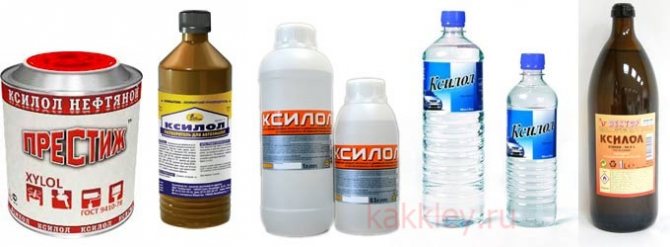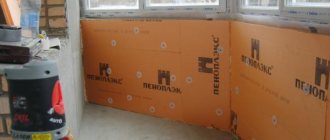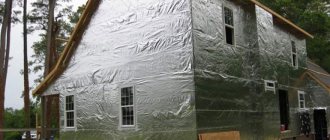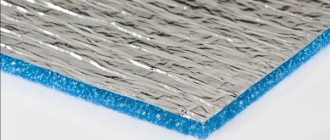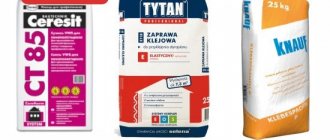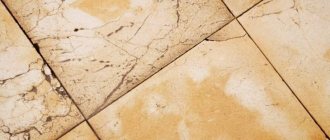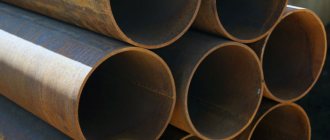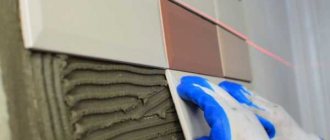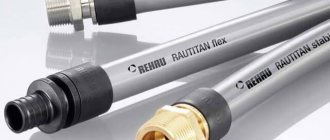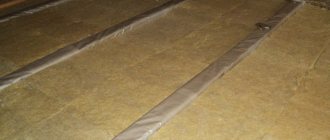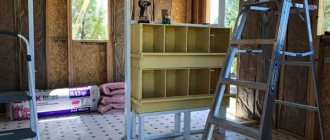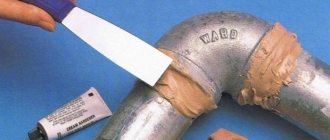A large number of modern finishing materials require a certain fixing. Roll or sheet insulation, such as penofol, is best fixed to the surface with glue. In this way, the loss of the technical properties of the material can be completely avoided.
Glue for penofol is chosen taking into account which surface the heat insulator will be fixed to.
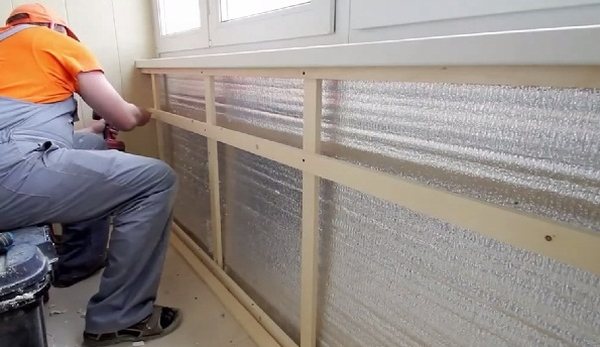
Fig. 1 Penofol on the concrete structure of the balcony
Why walls are insulated with penofol
Due to the vital activity of people in the house and the operation of devices, water vapor is released into the air. If the walls are poorly insulated, moisture settles on the cold surface in the form of condensation. At a sufficiently thick wall, the "dew point" moves inward, which leads to wetting of the walls.
To prevent this from happening, the walls should be insulated up to the standard coefficient of thermal conductivity, which for penofol with a layer of 4 mm foiled on both sides is the same as for mineral wool with a thickness of 70-80 cm.This example shows that by insulating a room with penofol we save the volume of our home.
It should be noted that it is really quite simple to insulate anything with penofol (wall, ceiling or roof). If you follow the manufacturer's instructions, then to achieve maximum efficiency, an air gap of 1.5 to 2 cm wide must be provided on both sides. To create such a gap, roll foam foam will have to be fixed to the slats of a wooden crate attached to the base.
That is, first you need to take strips with a thickness of 20 mm and attach them to the wall vertically or horizontally with an interval equal to the width of the foam foam roll. If the house is wooden, then the planks are attached with self-tapping screws; for brick or concrete bases, dowels will be required. Then strips of the required length are cut from the roll and are aimed at the slats with staples from a construction stapler.
When a layer of foam foam insulation is fixed and glued with tape, the same strips are installed on top of it with their own hands to ensure the outer air gap. They are fastened with self-tapping screws to the previous crate, and outside they are revetted with plasterboard sheets or other finishing methods are used. Please note that the vapor barrier film is not laid, since there is no need for it, penofol itself is a vapor barrier.
It should be said that in practice, few people follow the instructions, usually penofol is attached directly to the wall or ceiling, and the air gap is made only on one side. This reduces the thermal insulation properties of the material, and we will explain why below. With thermal insulation of the roof or inclined walls of the attic, the installation of foam foam is carried out by attaching it to the lower planes of the rafter boards. This means that the space between the rafters is filled with another insulation, since one thin polyethylene will not be enough.
Also, the floors in wooden houses are insulated with foamed polyethylene, laying it between the logs. Again, first, waterproofing is laid, then a slab insulation, and on top - penofol. Putting it under the very bottom or in the screed is pointless, from compression the material ceases to be heat-insulating. Although in practice, such errors can often be found.
Another area of application of penofol is insulation of balconies and loggias, where the material is laid in a second layer after more serious insulation - extruded polystyrene foam or polystyrene foam.The installation method is still the same: first, lathing bars are placed, polystyrene plates are laid between them, and foam polyethylene is attached on top. After that, interior decoration is carried out.
How to reinforce reflective insulation on a concrete wall?
How or what can reflective insulation be glued or attached to a concrete wall? Thank you.
Reflective insulation is called a light, flexible material with a thickness of 4 mm or more, consisting of a layer of expanded polyethylene or another polymer, on which aluminum foil or metallized film is glued on one or both sides. Foil insulating materials are environmentally friendly, easy to install and significantly reduce heat loss.
Manufacturers of reflective thermal insulation materials do not exclude the use of glue during installation, but they draw the attention of consumers that they are most effective if an air gap of 2 to 10 mm is created between the wall and the thermal insulation. After all, air is also an additional heat-insulating layer.
The method of attaching reflective insulation to a concrete wall is chosen depending on the type of material, capabilities, location and purpose of the room. In any case, the concrete wall must first be cleaned of dust and treated with an antiseptic, and, if required, dried.
When insulating a balcony, it is better to fix the foil heat insulator on a crate made of thin slats, and on top of it mount a second crate for finishing
When insulating balconies or cold external walls with a heat insulator with a double-sided foil coating, it is necessary to fill a crate of 5-7 mm thick slats on concrete and fix the material on it with a construction stapler or glue. A second lathing is mounted on top of the heat-insulating material for laying with an air gap of the finishing coating.
When mounting on reflective materials with a one-sided metallized coating, it is allowed to use such adhesives on a rubber or acrylic base, as 88-NP, "Akrol contact", spray "Neoprene 2136", etc. You can also use polyurethane foam, sealing sealant and double-sided reinforced construction tape ...
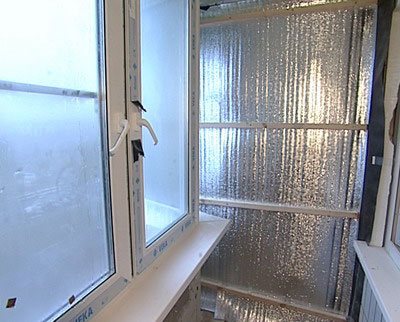

The reflective screen behind the heating coil made of foil heat insulator is glued in such a way that there is a small air gap between it and the wall
Reflective insulation sheets are glued end-to-end and the seams must be glued with aluminum tape. As a result, an airtight coating is created on the wall, reminiscent of a thermos, on which you can mount a crate of slats for attaching the finishing material.
After reinforcing reflective insulation on the walls and sealing the joints with foil tape, the room acquires the properties of a thermos: it is warm in winter and cool in summer
Finally, if an increase in wall thickness is undesirable or impossible, self-adhesive foil-clad thermal insulation material can be used for insulation. To install it, you only need to prepare the concrete surface and remove the protective film from the seamy side of the canvas, and after gluing, seal the joints with foil tape. But when fastened to the crate, the efficiency of the self-adhesive metallized insulation is higher.
Varieties
Penofol is the second layer of insulation and, in addition, acts as a vapor barrier.
- Type A - one-sided foiling. It is used in combination with other insulation materials (polystyrene, styrodur).
- Type B - double-sided foil. It can be used autonomously.
- Type C - one-sided foil, the second surface is covered with an adhesive with a protective film. It is glued to the main insulation or to the base.
- Type ALP - one of the surfaces is covered with foil (14 microns), laminated on top with a polyethylene film.
- Types M and R - embossed with one-sided foil.
- Perforated.It has the property of allowing air to pass through due to the peculiarities of the structure.
Use for thermal insulation of balconies
Manufacturers and sellers of penofol attribute wonderful thermal insulation characteristics to this insulation, which is actually a myth.
In fact, the presented schemes are nothing more than another way to improve the thermal insulation of external fences with the help of air gaps, since the intrinsic resistance to heat transfer to penofol is categorically not enough.
R = δ / λ, where:
- δ - thickness of penofol in meters, taken 0.004 m;
- λ is the coefficient of its thermal conductivity, equal to 0.037 W / m2 ° C.
We get R = 0.004 / 0.037 = 0.11 m2 ° C / W. Now we look at the comparison table, which is presented on the same resource as the technical data. It says that 4 mm of foam foam can easily replace 77 mm mineral wool or 46 mm expanded polystyrene.
Rminvats = 0.077 / 0.05 = 1.54 m2 ° C / W, which is 10 times more than foamed polyethylene.
Hence the conclusion: the presented comparative table is a pure fake. The data given in it are unreliable, and although the material is a good insulation, it is not better than others. The reason is that it is too thin, although in terms of thermal conductivity it is equal to extruded polystyrene foam.
Against this background, all other benefits of penofol pale. True, there is another myth - about the reflection of infrared heat back into the room thanks to the foil surface. But none of the manufacturers explain what the foil will reflect behind the interior trim. After all, infrared radiation spreads through an open space, it will not pass through drywall or other obstacle.
What is really good about penofol is its low cost and ability to act as a vapor barrier along with other insulation, as evidenced by reviews on the forums. In addition, it is easy to install and does not take a lot of time. You can also note the durability of the insulation, reaching 50 years, provided that it is located inside the building, and not outside.
To insulate the inner surface of the walls, foam foam types "A", "B", "C" are used - each in each case, since the material can be glued directly to the base of the wall (type "C"), attached to a massive insulation, waterproofing it ( type "A") and used autonomously, attached to the frame structure of the wall (type "B").
We suggest that you familiarize yourself with Products causing constipation in children with breastfeeding
Hello. We will try to answer your question.
Penofol is an energy-saving material with a laminated structure. It combines the properties of foamed polyethylene and thin aluminum foil. The material is characterized by lightness and low thickness, and therefore is often used on various objects (including on the balcony) for insulation, ensuring tightness, thermal, noise, steam and waterproofing. However, to ensure high-quality protection, penofol is not enough to lean against the insulated surface - you need a special glue for penofol.
For every owner of a house or apartment there comes a time when it is necessary to do the insulation of walls or a balcony.
There are a large number of heaters on the market that have their own characteristics. How to choose the most suitable one for the task at hand is described in the article below.
Foil insulation for walls has a number of advantages, including easy installation and relatively low cost.
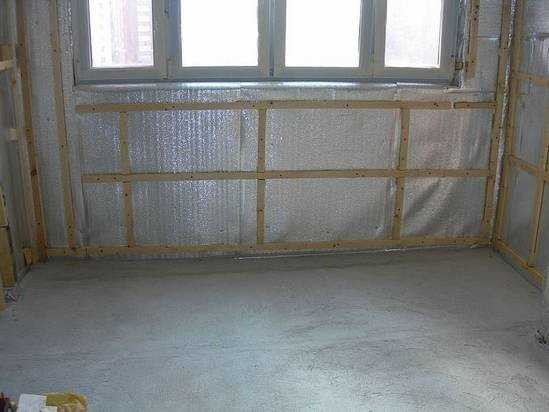

Insulation with foil has a number of features and a minimum of negative sides. Benefits:
- Foil reflects heat. Thus, the heat stays in the house, from the back side, does not let the heat into the house in the summer.
- Increased durability.
- Partially applicable as a waterproofing material.
- Easy assembly, light weight, easy disassembly.
- Insulation keeps cold wind out. Isolates as much as possible from external influences. Does not lend itself to deformation with sudden changes in temperature.
- Blocks out noise from the street.
- Does not rot or mold.
- This material is thinner than others, but 20-30% more efficient.
- The insulation does not emit substances harmful to health and prevents the smallest irritants and allergens from getting inside.
Minuses:
- There is no rigidity, therefore, it cannot be covered with plaster or wallpaper on top.
- For fixing, special adhesives are required.
- Sometimes insulation with foil is not enough to insulate a room.
Despite the disadvantages, foil-clad material is widely used for various purposes.
Foil insulation reflects infrared rays, which are, in fact, thermal. But, you do not need to apply the material everywhere. In some places, it will not work as expected.
Basically, it is mounted at sources of thermal energy:
- heating devices - batteries, air heaters. The insulation is mounted on the wall with foil into the room;
- boiler, fireplace stove.
And also it is used when installing a "warm floor". The reflective layer will direct the heat in the desired direction.
Small rooms, where every centimeter plays a role. Here, thin insulation will be appropriate on the walls and ceiling.
In the attic. Here the insulation is mounted on the roof. Apply 2 coats to combat heat and cold.
In baths and saunas. Heating of the room is not constant, the foil material is suitable for such purposes.
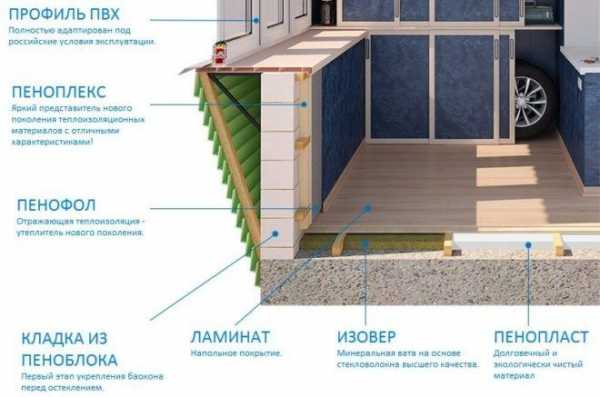

Garages, hangars, outbuildings - an installed radiator or potbelly stove.
They also insulate heating pipes, air ducts, wells and wells.
There are 3 types of foam foil on sale. Each is labeled with Latin letters, they indicate the packaging.
TYPE A - heat insulator with polymer, foil layer on one side. Produced in different thicknesses. Applicable for integrated insulation of buildings inside. Together with this insulation, glass wool is used. They also produce perforated foil insulation. It is mounted in log houses in order for the tree to "breathe".
TYPE B - the foil is located on both sides. This is the maximum protection against heat loss. Penofol type "B" is used for thermal insulation of the attic, supporting structure, basement, floor. As well as insulation of the pipeline, heating system.
TYPE C - on one side there is foil, on the other - a thin layer of glue, protected by a foil. Self-adhesive foam foam is easy to install without spending a lot of time. For installation, they are cut into pieces of the required length and glued to the prepared surface.
TYPE R - full match to type "A", but with a pattern on the foil. Used as a decor for walls in the room. And also with multilayer insulation, creating an air gap.
TYPE ALP - high reflectivity. This insulation is used in agriculture, for example, to insulate incubators or buildings for calves.
The NET type is analogous to the B type. Produced in a narrow roll or in reels. They are used for pipeline insulation.
2000 Type C - reduced performance. The adhesive layer is of poor quality and has poor adhesion.
The building materials market is full of types of insulation. They have their own characteristics, positive, negative sides.
General parameters of thermal insulation:
- Weight. The insulation should not weigh much, because, when mounting it on the structure, there should be no weighting.
- Thickness. The thinner the material, the more space is left in the room.
- Low thermal conductivity.
- Moisture permeability. The material should absorb moisture as little as possible.
- Noise isolation. Does not pass sounds from the street.
- Environmentally friendly material. Should not emit harmful substances.
- Easy to install.
Comparing basalt insulation and foil-clad penofol, you need to compare their characteristics.
Basalt wool
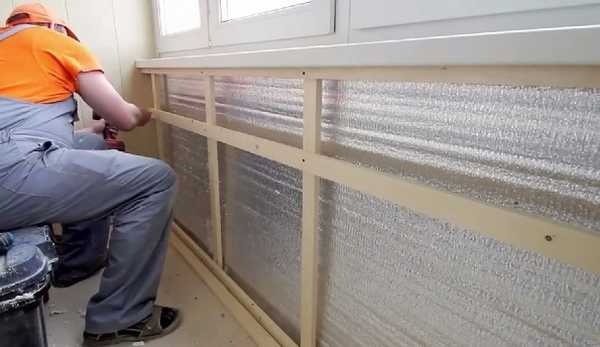

Produced from rocks of volcanic origin.It does not burn, has good sound insulation performance, and does not lose its qualities over time. It is completely safe for health.
Produced from polyethylene foam with a porous structure. A layer of foil is glued on top as a heat reflector. This heat-insulating material is several times thinner than basalt wool. In addition, it reflects heat and practically does not absorb it.
What kind of insulation to choose depends on the budget for insulation, as well as personal preferences.
The foil layer reflects up to 97% of the heat inside the room. This makes penofol an effective insulator for insulating balconies and loggias. Due to its small thickness, it does not "conceal" the useful volume of the room.
Before the insulation works, the old finish is dismantled. Corners and gaps are sealed with polyurethane foam. A heat insulator (penoplex, technoplex) is glued or attached to the walls. Vertical joists are attached through it with dowels to the wall with a step along the width of the foam foil roll. This sequence takes into account the high thermal conductivity of wood and reduces the risk of freezing. Penofol is attached to the logs with a foil layer towards the room.
Fastening penofol does not require special tools. It requires a knife (scissors), stapler (hammer) or glue brush.
https://youtu.be/4JT_Sud8sBE
We suggest that you familiarize yourself with the Determination of doses of fertilizers
The cost of the insulating material depends on its thickness and the number of foil claddings. One-sided penofol can be purchased at a price of 45-75 rubles / m2, double-sided - 70-110 rubles / m2. For laying penofol, contractors usually ask for a fee equal to the cost of the material itself.
Applications
Penofol is used as a middle layer of thermal insulation.
- walls of buildings (inside and outside), attics, attics, basements, non-capital buildings;
- production facilities and technological equipment;
- heat, steam and waterproofing of saunas, showers,
- insulation of warm floors and roofs;
- pipelines and expansion tanks;
- bodies of vehicles, trade and residential trailers, refrigerating chambers;
- insulation and sound insulation of air conditioning, ventilation and sewerage systems;
- as heat reflectors for home radiators.
Which is better - foil foam or basalt insulation?
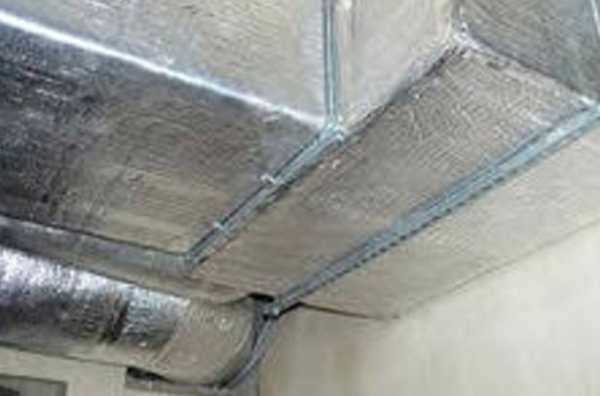

Wooden slats, 15-20 mm thick, are attached to the wall with dowels (with a step of 90-100 cm), giving an air gap between the wall surface and the foam foam. followed by a layer of penofol, with two layers of foil. Drywall is attached to the rail tightly with self-tapping screws with a pitch of 250 mm. If it is decided to arrange a gap for ventilation on both sides, then another rail is attached behind the foam foam, and sheets of drywall are already mounted to it.
Penofol itself can be attached to the slats or crate with a stapler or nails. Finishing takes place end-to-end, and the joints must be done with cutting so that the ends of the sheets fit snugly against each other. The joints are glued with a special aluminum tape to avoid drafts and cooling the structure through them.
In addition to the thermal insulation of the structure with penofol from the inside of the walls, there are two more methods of insulation:
- laying of foam foam between the layers of the supporting structure of the walls - with the so-called "well" masonry or in three-layer reinforced concrete panels;
- external insulation (perforated foam foam is used - it allows the steam to leave the wall structure) with subsequent external finishing - a plaster coating "wet" facade or a hinged ventilated coating.
Basalt wool
Basic installation rules:
- The material is mounted straightened, uncompressed, without folds. Fixed on a crate or directly on a clean surface.
- Penofol is fixed with foil in the direction of heat to reflect it. This is an obstacle to the release of heat energy to the street.
- The material is glued butt joint. The borders are glued with tape for sealing.
- For gluing insulation, special types of glue or a self-adhesive type are used.
Installation is quick and easy both inside and outside. The work in sequence and principle is identical internally and externally. It is easy to cut, quickly assembled.
Before gluing penofol, you do not need to pay attention to its weight. The material is lightweight and will withstand universal glue. But, for strength, they acquire adhesives intended for this.
The glue must correspond to the indicators of the heat-insulating material:
- temperature range 100 / -600C;
- indoor use, not outside;
- non-toxic;
- good adhesion.
The adhesive composition should not emit harmful substances. Penofol is capable of absorbing 3% of heat, which means that the glue on the back side can also warm up.
For gluing the surface and penofol, masters recommend purchasing the following brands:
- Weicon Easy-Mix PE-PP 45. Two-component adhesive designed for gluing concrete (brick) surfaces with polyethylene, polypropylene.
- Moment - has many positive aspects, including good adhesion. The glue will quickly and permanently glue the insulation to the surface behind the radiator or near the door.
- Liquid nails are capable of fixing the heat-insulating material for a long time.
Other brands: Titanium, Tilit, Atlas Stopter K-20 kley, Ceresit (CT83).
Type A. The material is fixed with a stapler to the inner surface of the wall or ceiling with foil inside the room. Laying is carried out "joint to joint". The joints are sealed with mounting tape ("LAMS"). On top of the layer, slats (1.5-2 cm thick) are attached, intended for fastening the facing material. The slats will provide an air gap between the foil layer and the cladding and, as a result, the reflective foil effect.
Type B. When using this type of material, the strips are pre-packed onto the structure. Sheets are cut to size, fastened with a stapler, the joints are glued with aluminum mounting tape. On top of the foam layer, slats are also attached as a basis for finishing. With this method, the properties of both foil surfaces are maximized.
If an external lining of thermal insulation is assumed, perforated foam foam is used. It is mounted with foil outward in front of the facing layer. At especially low outside temperatures, it is advisable to use the material in conjunction with foam or mineral wool.
The joints between the pieces of foam foam are glued with aluminum tape or foamed with polyurethane foam.
In multi-layer roofs, foam foil is mounted between battens made of slats. A prerequisite is ventilation of air gaps. The sheets are attached along the slabs using the same technology as on the walls. If it is envisaged to use polystyrene in the project of roofing equipment, then with the installation of penofol, the costs with the same quality will be reduced by 2-3 times.
When arranging an insulated attic, the material is laid parallel to the eaves overhang directly on the rafters. The overlap of the strips is left at least 10 cm. The penofol is fastened with brackets without tension, forming a sagging of about 2 cm. This will allow condensate to drain freely from the rafters of the counter-lattice. Since the flow of moisture is directed upward from the premises, water vapor, condensing, moisturizes the insulation. Therefore, a layer of penofol is attached under it.
A layer of type A or C insulation is placed under the finished floor. A concrete screed with expanded clay is pre-poured. It can be replaced with a layer of foam (5-10 cm). Penofol is glued to polystyrene or attached with an overlap on the walls of about 10 cm around the perimeter. The joints are sealed with aluminum tape.
Moisture that is impeded by the material can settle on it. To create a ventilated space above the foil layer, slats (1.5-2 cm) are stuffed. When installing a wooden floor, their role is played by logs.Lags, like reiki, are impregnated with linseed oil or antiseptic.
Nearby wiring must be well insulated.
When installing a "warm floor", the insulator is placed on a dry screed with a foil layer down, in another version, the reflective layer is directed inside the room. In this case, a polyethylene film is laid on top of the penofol. Type B is used for arranging the floor of the lower floors above damp and cold basements.
We offer you to familiarize yourself with the Rotary plow for a mini tractor with your own hands
When installing a "warm floor", if it is planned to pour a screed over the heating elements (for example, under a tile), foam foam type ALP is used. The cement slurry is aggressive towards aluminum. The sheets are placed on the screed upside down with foil folded on the walls 10 cm and glued with aluminum tape. After installing the heating elements, a reinforcing mesh is placed and the screed is poured. The edges are trimmed.
Penofol types A and C are used when installing a warm floor under a floorboard. When laying heating elements on the material, remember that the foil layer has conductive properties.
Insulation of the floor with foam foam is provided due to the reflective effect of the foil layer. It promotes uniform heating of the coating. Impact noise is reduced by 20 dB. The penetration of moisture is excluded.
https://youtu.be/diJknmnRqZc
The main advantages of polyethylene foam
Despite the availability of heat-insulating materials on sale, the production of which began later than foamed polyethylene, heaters of the Izolon, Temaflex, Polifom, Penofol brands are in demand by the consumer, since:
- the material has low thermal conductivity;
- the air-bubble structure of the insulating material prevents the spread of water vapor and the penetration of atmospheric precipitation;
- the small thickness and high flexibility of the material facilitates installation, and the glue for expanded polyethylene ensures its reliable fixation on the surface of building structures;
- if foamed self-adhesive polyethylene is used, the installation of the heat-insulating layer is greatly simplified, it is carried out in the joint, on top of which aluminum tape is glued;
- if foil foamed self-adhesive polyethylene is used, then after insulating the surface of the building structure with Penofol, it even acquires a certain beauty.
The most popular type of insulation with foil for finishing from the inside is Aluform
Thermal insulation with foil is produced in:
- rolls;
- mats;
- plates;
- cylinders.
They differ in size, thickness and the base layer used, covered with foil.
Base layer types:
- polyethylene foam;
- basalt wool;
- expanded polystyrene.
The foil is glued to the base layer or applied by spraying.
Some have layers of foil on both sides. Or with a layer of applied adhesive - self-adhesive, which allows for easy installation. Self-adhesive is used in corners, on uneven surfaces. Insulation joints are glued with foil tape.
When buying a heater with a reflector, you need to pay attention to:
- base layer;
- foil thickness;
- taped with reflector on one side or both.
Depending on the base material used, the thickness of the insulation itself is.
Bestizol or alufom is a bubble base, consisting on one side of aluminum foil (outer layer) and polyethylene (inner). Foil acts as a reflector for solar and heat rays. The polyethylene interlayer has a cellular structure and neutralizes sound waves and shocks. The advantage of this material is its low thermal conductivity.
You can use bestizol both in frost and heat. Due to its small thickness (1 cm), the material is used for hard-to-reach places:
- for winding ventilation pipes;
- pasting of air ducts;
- insulation of pipelines and other outgoing communications.
A large number of modern finishing materials require a certain fixing.
Roll or sheet insulation, such as penofol, is best fixed to the surface with glue. In this way, the loss of the technical properties of the material can be completely avoided.
Glue for penofol is chosen taking into account which surface the heat insulator will be fixed to.
Fig. 1 Penofol on the concrete structure of the balcony
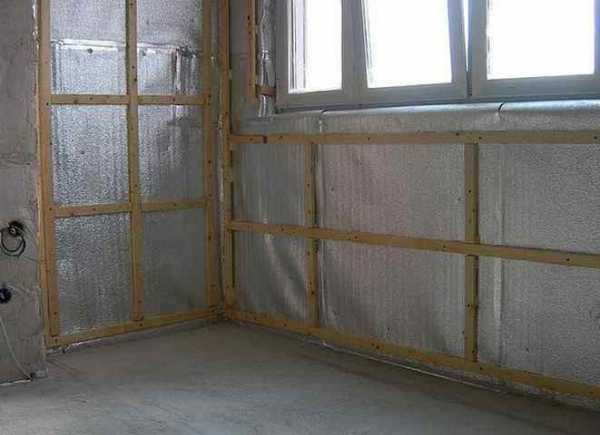

Penofol is a foamed polyethylene coated with an aluminum technological foil. Installation of the canvas is not difficult due to the lightness of the material. It is used not only in construction. It is perfect for thermal and sound insulation of machine parts.
But how to glue penofol to concrete? After all, it is a very unstable material with high thermal conductivity, heat capacity and even the ability to accumulate moisture.
https://www.youtube.com/watch?v=RgKvM3-JFRU
To fix the insulation on solid brick or concrete surfaces, the glue must have a number of properties:
- Have a high degree of adhesion and hygroscopicity;
- Do not destroy the material;
- Be resistant to weather conditions;
- Withstand large temperature drops;
- Have fungistatic and antiseptic properties;
- Do not lose their properties over time.
For the best fixation of any material, special solvents are added to the glue. They create a certain porosity of the bonded surfaces. Moreover, there are no universal solvents; each material needs its own.
But, for example, penofol is able to reliably adhere to penoplex without solvents.
If a bath or sauna is insulated, then when choosing an adhesive, one should pay attention to its heat resistance and resistance to water vapor.
Fig. 2 Fixing penofol on metal structures
An important property is environmental safety, especially when using material for interior decoration. Only certificates of conformity can refute the toxicity of the glue. Import manufacturers often use toxicity certificates under the abbreviation EMICODE.
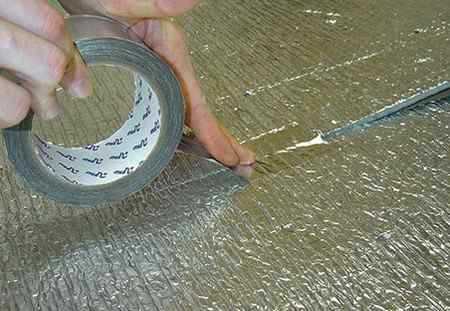

The technique of using the glue method of penofol is simple and cost effective. The insulation is very light, which means that it does not require the application of a large amount of adhesive. When fixing to metal, it is worth making sure that there is no water base in the composition, otherwise this will cause significant surface corrosion and damage to the insulation itself.
The surface for gluing foam foam should be flat, free of dust. Concrete walls or floors should be plastered without cracks, and metal surfaces should be treated with an anti-corrosion coating.
The glue is applied to the non-foil-protected surface of the penofol in an even layer. All sections of the insulation should be oiled. Particular attention is paid to the edges of the panel.
Before fixing penofol, hold for a time from several seconds to 1 minute, so that the glue dries a little. This will ensure the best adhesion. After the canvas is pressed to the surface, holding it, gently smooth it until it is completely fixed. The seams between the pieces of insulation can be greased in advance or after finishing the entire surface.
Penofol glue
Finishing and renovation work often involves bonding various building materials together. Sheet or roll insulation cannot be fixed on insulated structures without special devices, otherwise their heat-insulating properties will be lost, and their wear will be faster.
The content of the article
For such purposes, the material penofol is optimal, which has a layered structure and consists of aluminum foil, supplemented with polyethylene foam. It is characterized by low thickness and low weight, as well as ease of installation.
Such material is used for finishing building structures, units of specialized machines and whole mechanisms, individual parts of technical equipment on a production scale, pipelines, air conditioning systems, drying cabinets, as well as inclined surfaces with a complex profile.
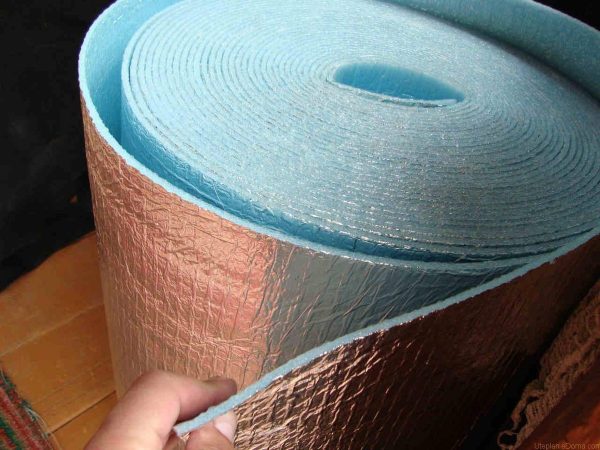

In order to ensure maximum steam, thermal, hydro and noise protection, Penofol must be glued to a previously prepared surface (cleaned and well dried).
Before proceeding with the gluing of Penofol and the work surface, it is recommended that you familiarize yourself with the instructions for the selected adhesive. However, there is one rule that applies to working with any adhesives, namely, all surfaces to be bonded must be clean and monolithic.
Previously, it is worth eliminating the existing chips and cracks, even the smallest irregularities, pollution, blockages of various origins. If wooden, metal, polymer surfaces need a primer, its chemical composition should be suitable for the selected type of adhesive. This is the only way to ensure maximum and strong adhesion of the bonding surfaces.
The adhesive method of attaching penofol to insulated surfaces has a number of advantages: it is technologically uncomplicated, does not require any professional tools and skills, and is inexpensive in terms of money and time. The only limitation of this method is the load-bearing capacity of the adhesive bond, which determines the maximum weight of the bonded coating. However, in the case of penofol, this factor is not of great importance, since foil-clad penofol and its analogs are very lightweight materials.
How to choose the "right" glue for penofol from all the variety produced by modern industry?
A good bond quality depends on the degree of adhesion of the material to the adhesive, i.e. the ability of the latter to penetrate into the smallest pores and irregularities of the material and adhere to it. Let's make a reservation right away that any material based on an organic polymer (including penofol), if it is not porous, has low adhesion.
In addition, it must be remembered that there are no universal solvents in nature. Each of them is more "specialized" in one kind of materials. Therefore, the so-called "universal" adhesives are in fact adhesives that glue everything equally badly. For such a specific material as penofol, it is better to choose a specialized glue.
In addition to the above characteristics, which are decisive for the choice of glue, there are a number of conditions that depend on the specific construction task. So, for example, due to the peculiarities of penofol when insulating the walls of a building, the glue used must be resistant to the effects of water and water vapor.
When using glue in a residential area, its safety for human health and the environment comes to the first row. Many manufacturers, especially foreign ones, are trying to obtain EMICODE toxicity certificates from the Association of European Manufacturers of Construction Chemicals GEV for their products. Such a certificate means that the glue is safe for human health and does not emit harmful vapors.
Application rules
How to properly use glue for gluing penofol and its analogs? Usually, to obtain an effective gluing, it is sufficient to strictly follow the instructions for use offered by the manufacturer. The basic rule when using any adhesives is that the surfaces to be glued must be smooth and clean. The explanation for this is very simple.
If the wall is dusty, the glue sticks, first of all, dust, and, accordingly, its effectiveness is sharply reduced. When there are large cracks, potholes, etc. in the surface, the consumption of glue increases greatly, and the place of gluing itself will be uneven.
Therefore, before gluing penofol, first prepare the surfaces - clean them of dust and dirt, patch up irregularities. In some cases, it is necessary to apply special primers before gluing - they increase the adhesion of materials. Observing these rules, you will stick penofol anywhere, easily and without problems.
There are a large number of insulation options on the market. Foamed polyethylene is the most frequently chosen because it has impressive steam, heat and sound insulation properties. The choice in today's market is really great. The proposed options can have a self-adhesive surface, can be foiled on one side or on both sides at once.
Izolon (penofol) is covered with aluminum foil, which allows you to keep warm in the best way. Its adhesion to the surface of the insulation can be chemical or physical, that is, sewn. Isolon can have additional characteristics such as thickness or color. If you are looking for a win-win insulation for your home, then this option will be the best choice.
Among them are:
- small thickness;
- ease of installation;
- ecological cleanliness.
Insulation installation is possible without the use of special tools. Working with polyethylene foam does not require additional protection of the respiratory tract and skin. The material is so light that the load-bearing capacity of the adhesive will not be critical.
How to choose glue
On sale there is a fairly wide range of various adhesives for working with foamed polyethylene. And it is advisable to make the choice using the following criteria.
- The temperature range must match this characteristic of the insulation.
- The adhesive properties must be extremely high.
- If the glue is to be used for interior decoration, then it must be certified and non-toxic.
- If the glue is chosen for exterior decoration, then it must be resistant to a variety of weather conditions and temperature extremes.
- If you intend to deal with the decoration of the sauna and bath, then the glue will need to be mixed with water-repellent agents.
For working with isolon, water-based glue is categorically not suitable, because it does not allow the adhesive to penetrate into all the pores of the insulation. Consequently, the level of adhesion will be insufficient.
Adhesive types
Let's list the most commonly used glue options.
- For rooms with high humidity, MV-40 is suitable, which has moisture resistant properties. You can also choose T-Vanguard-K.
- For residential premises, "Express" or "Universal" is usually used.
- When it comes to the installation of external building structures, then it is most advisable to choose liquid nails or assembly glue. For example, Moment Montage will do.
- Titanium is good for precast concrete base.
- Neoprene-2136 in the form of a spray or contact type Acrol is selected for adhesion to foam.
- Olfix and Ceresit are universal glue options. They are perfect for working with any kind of surface, including concrete.
- Atlas Stopter K-2 kley is chosen if you plan to glue insulation on a mineral base.
- Weicon Easy Mix PE-PP-45 is selected for bonding polypropylene to polyethylene.
After the work, the seams will need to be treated with Tilit or a specially designed adhesive tape. The choice of glue is largely determined by the purpose of the room that you plan to insulate, whether you will attach it to wood, metal, concrete, etc. etc. Choosing on your own, without having a lot of experience in the implementation of construction and installation work, can be difficult. And therefore it is always advisable to consult with specialists.
Life time
Since foil insulation has appeared relatively recently, it is not yet possible to establish an exact expiration date.However, conducting experiments, we can say that the material does not lose its properties for 200 years.
The service life of the installed insulation depends on the glue used. If the adhesive has passed the expiration date, then you can re-install it with the same heat insulator.
There are many heaters in the construction market. The choice is so wide that the question arises, which is better. To answer, you need to compare the characteristics of the thermal insulation material and the scope of application - street, living room, garage or agricultural building.
Advantages and disadvantages of penofol
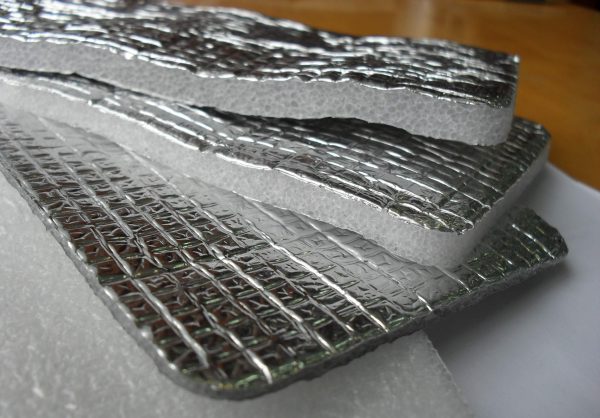

Advantages of foil-clad material
Even a person who does not have the skills of a builder can easily cut this material and apply it to any surface. Since the main components of the product are polyethylene and food foil, rodents and all kinds of domestic pests are indifferent to penofol.
The material is environmentally friendly and will not ignite even if other household items are ignited. Due to the fact that the products practically do not allow steam to pass through, it is widely used to isolate public and home saunas.
With regard to the shortcomings, it is better to carry out insulation with penofol from the inside. The product is not recommended for use when decorating the outside of the living space. It is difficult to fix it with glue and glue solution, and it can tear when fixed with nails. Penofol is inconvenient from a technological point of view - this material is difficult to "mask" due to the softness of its structure.

